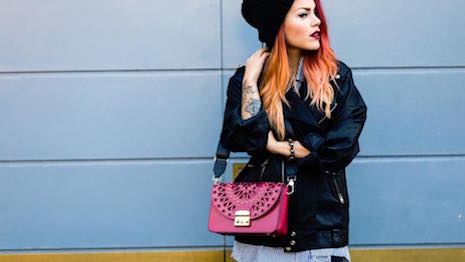Wealthy consumers are proving extremely influential in terms of retail, with 70 percent classified as affluents who double as social influencers, or what Ispos refers to as "affluencers."
Influencers are extremely powerful in making an impact on followers’ shopping behaviors and decision-making. The affluent segment of the population is proving to be a major source of this influence, according to a survey from Ipsos.
"The power of the affluent market in general, and the Affluencer specifically, is felt in every category, not just high-spend, luxury ones," said Michael Baer, senior vice president and team lead at Ipsos:Affluent Intelligence Group, New York. "Getting to know them and how to engage them is a key to driving growth for brands and marketers."
Affluent and influence
The Fall 2017 Ipsos Affluent Survey is showing that affluencers spend 40 percent more on all retail categories compared to the standard affluent segmentation. This is also 3.6 times as much as standard consumers.
Their influence is also extremely important by causing the most purchase intent in categories they influence such as 10 to 400 percent more.
Almost all affluents explain that followers seek out advice from them in regards to product and service categories with 97 percent claiming so.
These affluencers are many times the first to take on new technology and new products, which often spreads the adoption rates of these innovations faster.
About 53 percent of them claim that they are the first to try a new product or service before their friends, family and colleagues.
Almost 64 percent of affluencers prefer vehicles that offer the latest in technology. When traveling on vacation, 52 percent of the affluent influencers look for places off the beaten path for a more unique experience.
These affluencers also consume more media than standard consumers, even including print, with an increase of 9 percent and more.
Ipsos finds that affluents make up 16 percent of households in the United States and are categorized as those with an annual income of $125,000 or more. Affluencers are those who influence others’ purchase intent through social media and other channels.
Gucci❤️
A post shared by NiNi (@captainmiao) on May 30, 2017 at 12:08am PDT
Their impact can be seen in almost every retail and service category. Their influence is seen as more authentic than an advertisement to consumers and helps cut through over crowding in the market.
Additional insight
Luxury is far and away the most-prolific collaborator with influencers on Instagram, but brands need to be aware of how to pick the best tastemaker with the right scale and focus for the campaign.
L2 has released a report delving into the data of influencers to help brands understand how follower count, authenticity and other factors play into an influencer’s effectiveness. The key point is that not all influencers are created equal and brands need to pick the right influencer that works for them (see more).
Micro-influencers on social media have a greater impact than celebrities when it comes to branded posts due to their niche audiences, according to L2.
Celebrities and mega-influencers see modestly elevated engagement rates, but micro-influencers have much greater engagement rates. However, micro-influencers post eight times more sponsored posts and brand partners than celebrities, which can over time annoy followers (see more).
“While we’ve known for years that affluent households spend significantly more than non-affluent households (no surprise), the difference between the general affluent target group and those that are affluencers is even more expansive," Ipsos' Mr. Baer said. "Within the affluent population, affluencer households outspend their non-affluencer counterpart by more than two to one.
"Furthermore, they exceed in everything from the amount they spend in a category, to the media they seek and engage with, to the way they influence others’ purchasing, to their future purchasing intent," he said. "For example, in some categories, affluencers' spending and future purchase intent is upwards of 4 or more times that of non-affluencer affluents.
"This is clearly a target group that marketers have to understand and engage with."
{"ct":"fUoxBbqDNx7scEH8b9MHbceBPzw20LX1F39y5Ppo+CY+7rQgMpsmFIlbqtiM5kY1LqG7T0DUVklqhS9yqheavlbm0YR\/a66GhVyoDWr+lwLavakZLJGlliNMPnRRXoopxne\/7jfD1SISD2w7cptUktg\/v+vErx8J4ETmmuyBLjFAY1VwQPkZDdFhkK6cFZYsR096E2WZXUZn3cXRogshwH059t4EtoEyQJwdeLmCPhH0FkFCogeBreQZJooPALIPc\/3CT1FAT7DnIflRrXot6p20m\/QlzYvoMEZQpTNTN0Ep59FZQ8nY+02p4yUyfiuIME\/fDpNI5r9sNy9sDj6fI9sWxrehCb1gcoksg2ApAvJPhRpukv8MqyJDB8zh7yOyP6QFQoSZrU8\/LlJoBelx9mDLQ3Vc7oa5ZMboE78C9GAol3nNRM2nPl1Fo0pRjnFY6+c1Vy4KPkAhpFW4+Hfed2EfLFawwqAwdVjeZND93vqcoGHTTHPAKLtp7qllT8aQRjFzqVtCPUMipq2T2JNhDvihuix9VxFSXN3Koanl2SeBcDMWCP5pdF7r4d4giu5qHRfhKxBeUmXzb6atxseEoFwxlD5C9cnR8b9Uhn1GaYlYrrKWWAsVJnKxc1i5PNp7tq14aoco+wgTy9XU3GiUoNWaM\/QuFgNW8kGMQpeI2AixIDc59VdXp7whqqSL0BZHtloBhBpLi8t0kkm8SoDyWQcQaelMP7sAImn4y+7HRSownXcR94MRp5nzd4XtX1C1WLKqpUX5JiZm8vVydtm+EN57jz8aGzxk4C0NIJA+75KoyTx7lc8bE6bry8fcAD+Z7nzsRN+8YxeFiJAqzraiGwiAFLPWvyPaWJD57z+2i29IKnptjPX+lwSmxWKKPruwf+NL7czX3NRZRuwsj8KLcS7O65k0SYLaL4DOMMPxYbs2Jvfs\/4ov5GZHYbT4ErN7lJkqmN3iAzN3QG2jNw5SdMc1\/rLgoaa3gYv9cg3+711U\/PykAlwyPbWT1tRFISvy5sX+odTbmyuNis0jpTlmF0V9mICZHhXI2SE7pra0g67nA99W2mQzrg9fVLFyMRkrLmxy0zE8LtJ6DAViXcJCTjfA8znRNRo+jubwqe\/0m17EPiq3FmWu8OAAUZnhojfzMntOg9ExItpptBR8cQhuBRPCSfHtwYHXB3vk01393bsVnrL+4SO\/LBZwUk4qphAENHrdK18++bhqZKcc1hEZgJjk3FQWPW8BSCqcxl3Z2PKGcNoPv04L2vim2vsP8W3L9GO0Qxm7bEF8YfcKqblSUscSaSIZwR+\/mCjGyrUkorZxgKcGNS4GCweWX8A0i+9abvL16PWCL3dzEdjhVbPj0SQ3QgFlISZwqo8B4ekKtUWYfqHc6QLmJAGPWANMF1Ky1NHPcJL1c3yMaVSxuPvkqnSgpXfAr7x\/yF8FHc1W6AZ6LHEjbM0kXIH0u44arYTUBfrO0lVcXkLs\/P0uFSHV7wZM32VN5WXEmdZx60o69aAAnSeWoBHUF5BByg0wTqYNnF5LyJKUll7sM4VUcL9a8emndvivSig6wTCsk+SJX\/qoU+jWddJ7KeMuhGvVJCjIFfFcNs6r8kEEqydH7jaCYBBuTUYu\/Y9WRwp2GXzpRWpn7BbrX4Y1qWD1DElfykLJZvmrn00id6ZTjes\/uGBtIhhQJ88HYQ3kOhzSSC0Rz3s+gLk26iwjBg8MjFqJ1JqWu9VAfJzSE3Q+kfAFry+2LMk9Gh82O3RxdqhQbXktRylhdxeZrihXCBG3ig9KkvYL7FIkZuzdaOXuWcXmEFPmaLmq2JLdEBNtqEwiRA\/aq\/b0lnilGbP+Hr0AbRCgr9pk0szuJojskLOkSp+6bX3QRZ+gVdA7wV5NOVyq0\/HXr+X2ZANjqFtp4jq31lWJl1dnNhmyeMoCkkvRHd6agyg1g24RtHrWEpZiTegLqiW6IKOutKdEpVrFI9sfpHAKBHc0nduWA8iYVKywxzjv5cz88sEGY7yn3nvcwVzF4I2f1nPJlz\/H6+s7wMLETyj\/qewNvmU0MCx\/mIp2ObDYWKeBOQqNHHBfO32PClE4ZN9jV37fAPGm279TMAGsdViUsCCYO4bT\/GXwZlRoqzExsiG\/fmO7Do1NHXTP2yOAwbzqGZJiL0PsVfH3HkDYs8bAC2dXKIKXT0zcwHf\/OTGQFjQwsqpZcngSy2qYiJL9PAX4MVk\/ixdvseoV2CGrFGwtTKkk7Dk5jS0+Cja2dBJqrIz9SVblWpHxB3UL+Tm4I\/fUv+3N4KT5JBc6nBjVdHwg7zYCcFC5gUFfReyL\/sSKDlvK+oSgDibT1YdJOta+NwYYabKWsuLkjb\/a\/5c2FM8ojG7k\/k+9bhm+qV7RR4XHlwuGuvL1NkuzeUkz595AgLKdlb+ZJu9L7BX3f7nKHGrn7NZaNQZwd4vRRbUrsZuGyg3zoGJpdSLNFfkPecul7IZvWz1HcYNjHui1821hsDAiBwH9eES4EJYHYudyiI5JzBv6nS9mCtLbZfGLHl21gj+xYqny7jTj2ob9j08ost7+Y1jJrx2glT1pQthkHSXiW7Fl80UNVvt0nsBuiRTOmz3SjxJ4vFwUdDNGHYHnEQEuoTDnHMZ+fnFFMpCQzkcSDdLl8DlPCpEZ\/n7wduraKRLkJB\/3adGnzuAUFB3B1QGvmGk7NDEiGcAm5JhGpX8qhm3dQ1QUKrm\/pT0odOY4CYKOIy2ieV1L8LixZJgrCKLeyqMwH2TlC9hzKKRQ3tP\/FZjoDHLJ7db6UUDebpCAMs4FlwdUlz9qbIlQGvRw4V7BY6UZpmYFnLIDYaUMChJpUMJ2gdIfjsRvDPKGZ45divleeyXGq4ZA70VcY2diXTaSMDYMq9wp\/CDbiV2YT5DQ1Q\/euzZfj2cJTaubfMV2JXXS+TGu6eoBudeBUH9K4rcRAMaYfjZekJKrjSj9Tdcg96oc7HDFR0YSkPNGwdWbFPa+gQR+VUQLHY6XuulCDScKvUlZz\/VJtFd84O1IVwpGMWZ\/cinRywjhsMLLVkITrtCdUX2bjmMMnFbOAFPbHfk\/HL9gvGSPBrv0vX6Lh611DO8KQJhFp47yfW5TrGpCTwcEJRrExWI2DPPxA++\/dzW60yVIPeYgGMmpSIHQ0xMbcoyR4eJblqge4GvKQg4fAQtDOqB362dmQJH0QFqkYiC+hGmGFJdaQdbJqtOw1TLK4tKs8pbeI5EuLxGfPtOr7h9vgxol0WK2MrX1NGSQtN8GrunAGI9XMzuZnX1FE5X2d43hxhwWhUa5pWChTMiMNufQPQNYY8DQSPLivr1yGdNpp3Wq6vjPK09q86hTAM3FpW8nXHCsi5\/AgMMt2B97cP4ixmttpwwR3vY97bF7mBAOsWjW5zISWMfhzOcJMe2eo5LI9\/bOlSNL41sFNdhE5RryeAXELC4Sd3Ae0wustgtXOs\/mnklFld3XpPe3r7IitlN4N8bmVPQj6o9A\/WN4VIUx3xMuD03LjL2zJwMPfWnc8CDFTCbA6Sma6ATG1jaxoi1S0RZZbIU0SzAT65jF\/B+41Wur10PIhR+L1DDMBXy+apnwMVOHqSrNP3BIJxNv6RPkFg21tmDFFw2YODrZ+7\/JZEZ5ypibfiZ2Kq+bDYYR+QKR5XflZ4SgywI8x142b4qhZI030tOFnGzLOQM4OudpagJ3pu6kFh+TGJlWpw6X389yEifSB2\/7NGozXnD4NBhWDVJqOwHs\/vIviMExCiBTm4fe46KooJH4NaMh5cBZqd4s5avEo1KgXLKrTUAouYV8BG1VWwG5eKF3LtBnlw3rn0qjG4NygsPz3u9LjXVPa5uTmwsi\/Hfy3fg1kjUM7B5BLT95OZwn\/LDKMHzbksGi6xEuW3DKTlb\/2Lc+rI+hkY0rPj6ZU+woZ\/hFzRBkS1GEw\/EsYLrhZ5UZAMRv+5XP5pQn1jTRHP8wV0VOS3Oh4SKTSen\/sheFj65F7RfEDyfTdTyqzWdVj39hEYRUYIRIiiw2DyzudPRGEIjL81qbBk9jJIM+Rh91aruSOHE8gjGOFZl9kX315\/Gf69W2OQpI3y2jTiajHXkCMdupYL9g\/jERs8iSRmKdP+Ydv1aOci6mlgwyMqy6QIY6IqSERSMPVKSUBaIy4dBzvXsmSEeV3hMw6VYi6rgWcGbPyDTxWw2rkIm26tSn8RPHGwP7\/Krmha4IRt6G7Efn+j9vyruZNO8PvPMzRgmT9\/zlNbjRnkPYeyiWxxUlM+FQDcOvLcY5PwjpftY4Ylh4ubPKJJ\/ntArcUT4bGsW8lK7aIHJqobcQ6wwT9XYHr7bNpZNTIvysFGVOzxR91+hOJyXej0UugJTQrpgNzD56ni8fqY5DtyxOyJPHRZm1bUxXFqUjUo9w7J8FKWtESWukVB9l4eeAA+ChOLrUlcpHxOmVWnWyKOngWgI1G4If7By3ZqMYFH+2LBhLFgDr7fEVqOFtppKT9IkU5OOGeYFaUsiNSxrCAbIEiNi+yrf6cv3G3WJaVqxFw7iMrweY9UtNHtNdO9LFZdeJ+dOQsYwTaxJ0MY\/5\/hvwzO7iyGtwbJpOCCfHzQu4CLGudi5Z9Q0Am9o3OR3lFnc5\/0nU7S3ehbmD84AJezRbPtuauLv3ev1BzLu18W8FGZMAYcnXqS6u0vxtVF0NQRhAnkl5QfZ0FAFuBbO0WLtAWLyF2xmfaVGhGEuqr86pY+X\/UTxy2MK2SMe2OR8nU3xL7mpC9g9sXeIxj6RWOg3897LFTA\/ffZuc\/wRX+\/vcZYVZzr6tvbkT2XJ8cYGI5yEozNGzS5rPQGFcq3sW8jTw\/jzABUp5u1YEmDF4JL1buMGVktI6hBJG0acejHNMsRw2ZD7PS+BMAQ29FJ0FOXg3bkBEqcyXEw+iRiWxLudKHeAwhOOIU5gk\/r2Mv+1suu3ykOZZ\/9TXcaVfx3cZIphIC3xq8sB1M5wJephEsvGIqTv\/LuuR\/f2bwlcTD6DBJbr2imKYBFhEUGtDUFaxdyz1dqHkTXpoGbleSuPkYmFbPSWgUnKLdhPUOaP1sSmdGiDp6OkqjLHyR39PWlwC0zhCwO8hG+ieiqEglrHLRbNMU43TaCXNnpxadt5RgQ7Jr1y1Flbu6I5x4i0u3ACzwantBKSArB4TQyQgIyQBuRw4mYEnQY+kb9fVpc4nXwNRMsAV4WlUD7Lq9cLede3FmBB\/irbOdgMMeyRLU+hdwEqnoOBj8WniP4uEdxU9AQ6f6u82iVZpy\/0cN0Z05Cet4pu072ST50rjMT\/DNTq7CWlrIQqRSRzIICYQWUxXqAPfIbQGzZ6a37oWVNq2wy\/jMJN9XARaTo\/a3rRGB8kehe2vonRG2V4uE2UQ4pWQvB7cSDi2oJLSU\/D7O8SvVII5VNCqL7xJC8J82QwvXZvWkcU3SVgrNhEAx8uM5vGau4sBpirO6kqJ5\/mc+h7qFDN9tQyiSbtxOqumd42OnSSvkRKfnLgGCkGmNrox\/Ik65NRUckxTaRZYFt3DKwC4iH01CaBOapJ6G\/gZRxrsvve8yWk42lIcIZaZGmjBe05ZG27Qx4bTOLa3sM4VVRHcBWDDbZeBvBGOKUcohqx03mZrH9XyILBk1McZWcCsgksEFJ0aT3lYAW7OgOaX77qUtWtK1zBneMlhxWV4Y0OC5Ld4OETqhg4eaQKB3PjlENujEoMRn2yZWzZ+fUpBFesrDm7VvMbJKsOPUyUeL2otEA\/wDrW+H6Zg9DgZVpGz+22JpJ2nCuFZ4Q4MiyNKZOv+qvYqTDGVl5LA43\/Zj1rKTOTQJPsoEeHTss4aN9jof3PCd3EzpxJuJSPQCxiP3YnJwEH6OgCm4XVVKZfXPkqoi4\/qxIbH7mEGdEq\/nmD0iEo9se3tLeK6ptN5xD4UIm\/HUfjcge7K6By4kvoaoOhuW2eOeBvKfxmnhUCkJmWwS+ezKsnhtCOuCOLAPIPlqVwFenLvIW9r8PUaJpI7OSArEniAUj200kYzoh6VOt7sE2aQdrzVQUWPOrbyw8tr7PqHeTVkgmqs76MPbHAEGtp6NjEfvnrweCT6yco5fsW9bSfaOz4\/i3GQFdDWiRYSfyWwL+yL45zubSxzWt5PUZJG8cAICCnKAkQe+kxpJfTs63MiHCy1ATAo6ZdBC4mLqLy17Fw0TKphLfUoUbZbEm2XIkjFyI4hpgrFVRpbp+x7LT4V2gBitgCjexPWXXrPhbUq8nyDy9WvXAemrPhkjqxCqbuGq0R9DPLywnXPh1KkmkmPvBMEhmEjBhLrbkb\/JOqldDvKC22JWyb\/Mnet97zYBIEkVex18tRc4bcfeCSNyCFcWOj7SXyNZ8RtwxFg4cKYtzKx89JUaPJ5ZrFGtTJP0XVAyT6aM2emIuqZUjx5BlbHtNdaj1Ig7ldrofhp3RBbK2q6FF0yoRA1w4a8cL0TSlm7W3Cs2l4lbj54sHGdSRx\/DltFWTfodKpc07pOingCGvXgjbQvjrp5+VuQU3ZBRN3PIB\/xBqGMtUtH3GTMjQFVsjkPQGeRr5KCT+RQEz0xCehmODvQ6SSlJBO38n\/pQTsiFECLt7l+GaYxhxPGr1\/oNKnQc45LwwpS9bEvqgcZv\/5M1IO8V9M6l1A4EN0PZQf9pafBSbnufFJepgKlCDtoSuMI5y+lc2OaVn1Uo5e+6Pv2oRapeBLsWEW9oJfaYFrF24FB0uEsRCu2fQ5\/824\/N5ZvyclknbWsEYXAQXJpOdZ2jMRuuNdNMXO9yNesfDK2fH89hmgm1g\/G4AbbDYh8Maqzr9dVzslH5vZlGTHrOymlkyWZL\/JMSJ\/YI1QxYMSXgtyW\/+7WmQxOvPY1mLQ+N\/jX5TYm4rB30ua5N3UF6VYzcAhGXVLT0jx\/r1ZLfmrDM\/7WQ2na7ITRR\/0dDa3Gw14eT7u+OteS4pO+SMbLastuunhhhUiPHwciSD0Jqp3u1hWnBlP5TwNGHn8lyD+EM8zHPSXoqJYixG+SGJR1UadQnYiZgAgqsP0R0sn7sX1zBvcJmRXu+k\/LHlSdYQtgQ19ilW29fHMtJIgacIdH\/fJEnVxLBJFH4INEHwC\/nuPQPqfNI2i9kOQgrX71SLW3bxMxi0bC\/vN2iCOEEX\/grQIIZbfs9rsM6fn8UN1OdDQ\/qb8EA+mOqVouevhxXRiE7rPUkheRDk0CKxOrc1g70Jw2Y\/obZrBZYLEf4bpL3BuIbPMYt\/Os7fJQrk4OWrqkaFrHxNWqBPa+6bZ2S9GS1iRyxd7JugC1TpeaYAAWoFHcm5C7Kpqtv5DW8lz45\/b1MryvPlvi6\/L2BH7sjh0BdJ9swNw10V\/LPZeZVdUk3VtJlpFVpKeLDi4xFihc48FRxLXchq79jEXHHR7S83N2zwQMZKZNGjmzYywZIge5o38RIvqVbSy9\/jzWGfzDWhQPnY5UbgQp3JL8UljieAV13xvLMu\/hyfuCYaIKLWvLK6AdlAUg63BJQZ1a67dVU8c3hA0dgZ0YKs89feIY\/kANUEp4cxWqnNjCRgt1oDK5iqlG50T5iAX8lTMuc\/R9fddCW\/MV9SspTnSeWi\/V9D63PsGH6NJKqkstCQPr5lPj\/WLA+O+3aQfCzVAT\/HIqak2FDNmd7M1xKzJXIQvTBgNyy7g9kUHx6rVV+oCGS4seeY\/OhdjwigXeE9t4NLEbUAIFdMCGGNMP\/9cUYqeER3wz1n4ftesvtRcAaioxplAAjWRwa+RkqgIjdSR0nEd0CJkB3zS528CfrVfMbEfVLaTQ4OABLCl4gLsIXP10FmevDmPaPbd5RdE2suNN7LEU1dJsfoNdDDo0IxRAQucTMFjY\/z47i4a75+TclidDUxzC+ePuDZVFqWei00stF72QPJe443DHCOXqrf26Rru\/g7L9LgU6KYiKTPBluI635IpHKwKdqxjJgDhjk2l5wFLZMi09qnMxOoZtZEDQsaBxSKAV7xaCp5k2p4Nce7bGUkYa1rFAducQ6t6p7BjSTigS6PbgUzvF5311sfT+Fc7MH6s+U6VL5mei44YbrY\/YeHNIO9ufGKHjsDr5\/moqunkWDm+YaV194hX4dWd0xlBdG+jcYiJvzDMZOhNkgdmIy47hIh1IHypij95XXGFnnRAvj4dkQ5L4KKujr7hOyCDM3q8cyXS1ApQiw4\/JXDnXBwAxbdgtHhctdLXZOofYVIODqMAhZl54eoJH7kUewd0tpKyBOokGn87EZ\/UUNOON0ZUwEzMY8xR1SQz7tbfLv6OkiBfAq0tNPu1zQgn3wZExI6cx5NcB5nsrQ1Fwu\/Lmg7iA++c8oEEjouxlhqPlSSIi\/YgIl9nhVqn3BNcvd7+W\/b7ANTkqY6u4U3P7vg5Xu7lRZTrlQHfE9Oc0omNw6Cw07Zj0HOO5ZbuCFUv4nage\/7qHn9yjEHreqWxWNtmDUrWUGQMwGq7exP\/nLIx3FHzkAkLW4+7baVV5UF64+vr\/c3Lrowq9jnhnwI2gtxQiGMPbg8VgBoccljxenc5gGVBrtPhr+aeyJbpO\/B57Ft3yqm1QlLCK79xGHQl8565mFBoTQ+S264weRhFbDuxGJWMADkeWA4PfaIdTZWQoG4OBUwrzt4fQpvJN8wu9V80bnHmmYeFYt\/t4PptTVWt52wdh2j7ZtxkCdZcGN9mRY9IJJ9aXgEcxTFV\/1oQd68GxPKrFmGpWzlMk4G84Bh7Q4D40nAumqlJytomtsFLFviNDqPA5gcfnvt2NNI8G7ZdMB1+Ns8MkdWI8MeOx4BbeDTsKgy0NvD2i+54wTJPaRa98ewoqZh2pPgi49y2sGTHJAzJI8P8ze1lPKrKxF7TPc2IwX7XV0D75GllqGd0QHRhuzsnSVXLCaAshoSpasrbLgA95KQCmtU0Em7Od\/C+SvFBq+6Zn6\/o6uuB3F1\/LnPp9hPIgCDKzjJmrnTxPMVpXXUimgvtku4zgqARNQyrmU9WjUpPH2sd58LMh","iv":"8adfe59bbbe3bdb6900e007bf7595599","s":"bc814aa2abdb4530"}

 Fashion influencer Luanna Perez for Furla, fall/winter 2016 Milan Fashion Week
Fashion influencer Luanna Perez for Furla, fall/winter 2016 Milan Fashion Week